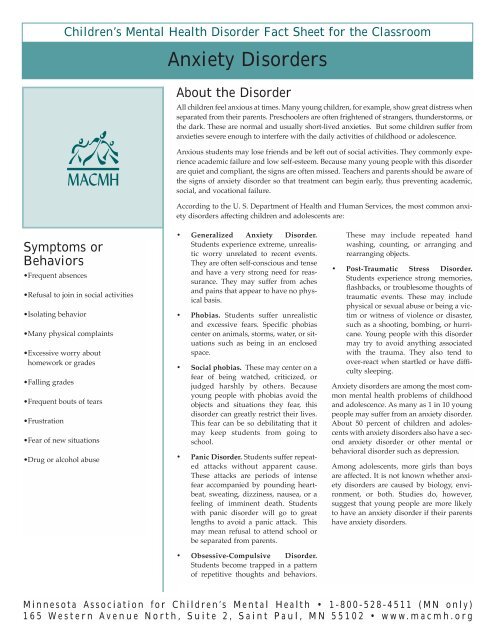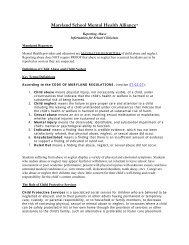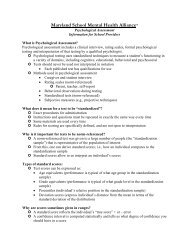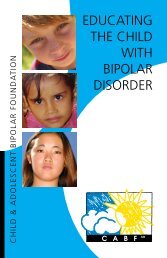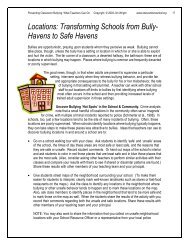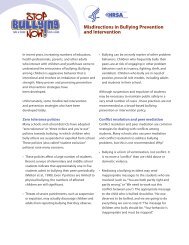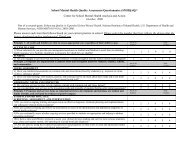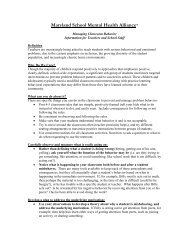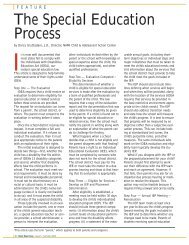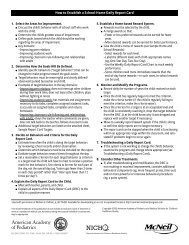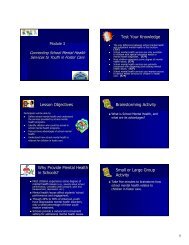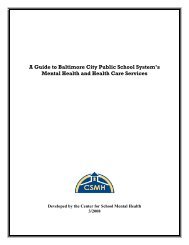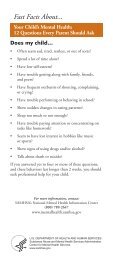Anxiety - School Mental Health
Anxiety - School Mental Health
Anxiety - School Mental Health
You also want an ePaper? Increase the reach of your titles
YUMPU automatically turns print PDFs into web optimized ePapers that Google loves.
Children’s <strong>Mental</strong> <strong>Health</strong> Disorder Fact Sheet for the Classroom<strong>Anxiety</strong> DisordersAbout the DisorderAll children feel anxious at times. Many young children, for example, show great distress whenseparated from their parents. Preschoolers are often frightened of strangers, thunderstorms, orthe dark. These are normal and usually short-lived anxieties. But some children suffer fromanxieties severe enough to interfere with the daily activities of childhood or adolescence.MACMHAnxious students may lose friends and be left out of social activities. They commonly experienceacademic failure and low self-esteem. Because many young people with this disorderare quiet and compliant, the signs are often missed. Teachers and parents should be aware ofthe signs of anxiety disorder so that treatment can begin early, thus preventing academic,social, and vocational failure.According to the U. S. Department of <strong>Health</strong> and Human Services, the most common anxietydisorders affecting children and adolescents are:Symptoms orBehaviors•Frequent absences•Refusal to join in social activities•Isolating behavior•Many physical complaints•Excessive worry abouthomework or grades•Falling grades•Frequent bouts of tears•Frustration•Fear of new situations•Drug or alcohol abuse• Generalized <strong>Anxiety</strong> Disorder.Students experience extreme, unrealisticworry unrelated to recent events.They are often self-conscious and tenseand have a very strong need for reassurance.They may suffer from achesand pains that appear to have no physicalbasis.• Phobias. Students suffer unrealisticand excessive fears. Specific phobiascenter on animals, storms, water, or situationssuch as being in an enclosedspace.• Social phobias. These may center on afear of being watched, criticized, orjudged harshly by others. Becauseyoung people with phobias avoid theobjects and situations they fear, thisdisorder can greatly restrict their lives.This fear can be so debilitating that itmay keep students from going toschool.• Panic Disorder. Students suffer repeatedattacks without apparent cause.These attacks are periods of intensefear accompanied by pounding heartbeat,sweating, dizziness, nausea, or afeeling of imminent death. Studentswith panic disorder will go to greatlengths to avoid a panic attack. Thismay mean refusal to attend school orbe separated from parents.• Obsessive-Compulsive Disorder.Students become trapped in a patternof repetitive thoughts and behaviors.These may include repeated handwashing, counting, or arranging andrearranging objects.• Post-Traumatic Stress Disorder.Students experience strong memories,flashbacks, or troublesome thoughts oftraumatic events. These may includephysical or sexual abuse or being a victimor witness of violence or disaster,such as a shooting, bombing, or hurricane.Young people with this disordermay try to avoid anything associatedwith the trauma. They also tend toover-react when startled or have difficultysleeping.<strong>Anxiety</strong> disorders are among the most commonmental health problems of childhoodand adolescence. As many as 1 in 10 youngpeople may suffer from an anxiety disorder.About 50 percent of children and adolescentswith anxiety disorders also have a secondanxiety disorder or other mental orbehavioral disorder such as depression.Among adolescents, more girls than boysare affected. It is not known whether anxietydisorders are caused by biology, environment,or both. Studies do, however,suggest that young people are more likelyto have an anxiety disorder if their parentshave anxiety disorders.Minnesota Association for Children’s <strong>Mental</strong> <strong>Health</strong> • 1-800-528-4511 (MN only)165 Western Avenue North, Suite 2, Saint Paul, MN 55102 • www.macmh.org
Children’s <strong>Mental</strong> <strong>Health</strong> Disorder Fact Sheet for the Classroom<strong>Anxiety</strong> DisordersEducational ImplicationsBecause students with anxiety disorders are easily frustrated, they mayhave difficulty completing their work. They may worry so much aboutgetting everything right that they take much longer to finish than otherstudents. Or they may simply refuse to begin out of fear that they won’tbe able to do anything right. Their fears of being embarrassed, humiliated,or failing may result in school avoidance. Getting behind in theirwork due to numerous absences often creates a cycle of fear of failure,increased anxiety, and avoidance, which leads to more absences.Furthermore, children are not likely to identify anxious feelings, whichmay make it difficult for educators to fully understand the reasonbehind poor school performance.Instructional Strategiesand Classroom Accommodations• Allow students to contract a flexible deadline for worrisomeassignments.• Have the student check with the teacher or have the teacher check withthe student to make sure that assignments have been written downcorrectly. Many teachers will choose to initial an assignment notebookto indicate that information is correct.• Consider modifying or adapting the curriculum to better suit the student’slearning style—this may lessen his/her anxiety.• Post the daily schedule where it can be seen easily so students knowwhat to expect.• Encourage follow-through on assignments or tasks, yet be flexibleon deadlines.• Reduce school work load when necessary.Resources<strong>Anxiety</strong> Disorders Association of America8730 Georgia Avenue, Suite 600Silver Spring, MD 20910240-485-1001www.adaa.orgChild Development Institute3528 East Ridgeway RoadOrange, CA 92867714-998-8617www.childdevelopmentinfo.comNational Institute of <strong>Mental</strong> <strong>Health</strong> (NIMH)Office of Communications6001 Executive Boulevard, Room 8184, MSC 9663Bethesda, MD 20892-9663301-443-4513 • 866-615-6464www.nimh.nih.gov/anxiety/Free educational materials for professionals and the publicSAMHSA’S National <strong>Mental</strong> <strong>Health</strong>Information Center—Center for <strong>Mental</strong> <strong>Health</strong> ServicesPO Box 42557Washington, DC 20015800-789-2647www.mentalhealth.samhsa.govPublications• Both the NIMH and the SAMHSA websites havepublications tabs that lead to several current and reliablepublications. The Child Development Instituteand <strong>Anxiety</strong> Disorders Association of America alsohave extensive resources for further reading listed ontheir websites.• Reduce homework when possible.• Keep as much of the child’s regular schedule as possible.• Encourage school attendance—to prevent absences, modify the child’sclass schedule or reduce the time spent at school.• Ask parents what works at home.• Consider the use of technology. Many students will benefit from easyaccess to appropriate technology, which may include applicationsthat can engage student interest and increase motivation (e.g., computer-assistedinstruction programs, CD-ROM demonstrations,videotape presentations).While it is important to respect a child’s need for confidentiality,if you work with children or families, you arelegally required to report suspected child abuse or neglect.For more information, consult “Reporting ChildAbuse and Neglect: A Resource Guide for MandatedReporters,” available from the Minnesota Department ofHuman Services.This fact sheet must not be used for the purpose of makinga diagnosis. It is to be used only as a reference foryour own understanding and to provide informationabout the different kinds of behaviors and mental healthissues you may encounter in your classroom.Minnesota Association for Children’s <strong>Mental</strong> <strong>Health</strong> • 1-800-528-4511 (MN only)165 Western Avenue North, Suite 2, Saint Paul, MN 55102 • www.macmh.org


